The internal bifold door market is estimated to be valued at USD 10.6 billion in 2025 and is projected to reach USD 18.0 billion by 2035, registering a compound annual growth rate (CAGR) of 5.4% over the forecast period. The internal bifold door market is projected to generate an absolute gain of USD 7.4 billion and a growth multiplier of 1.7x over the decade. This growth is supported by a steady CAGR of 5.4%, driven by increasing consumer demand for space-saving and aesthetic solutions in residential, commercial, and hospitality sectors.
During the first five years (2025–2030), the market will grow from USD 10.6 billion to USD 13.8 billion, adding USD 3.2 billion, which accounts for 43.2% of the total incremental growth, with a 5-year multiplier of 1.3x. The second phase (2030–2035) contributes USD 4.2 billion, representing 56.8% of the total growth, driven by stronger momentum from urbanization, the rise of modern interior designs, and the demand for multifunctional living spaces. Annual increments will rise from USD 0.7 billion in early years to USD 1.2 billion by 2035, signaling increased demand for bifold doors as consumers and builders focus on both functionality and design. Manufacturers innovating in materials, finishes, and ease of use will capture the largest share of this USD 7.4 billion opportunity.
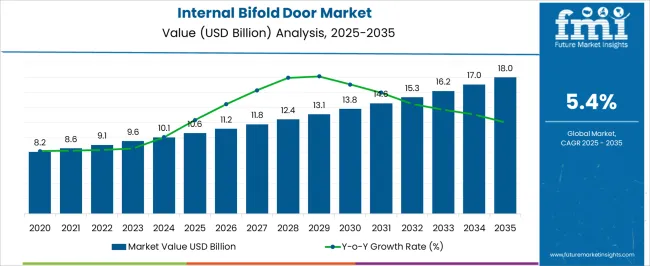
| Metric | Value |
|---|---|
| Internal Bifold Door Market Estimated Value in (2025 E) | USD 10.6 billion |
| Internal Bifold Door Market Forecast Value in (2035 F) | USD 18.0 billion |
| Forecast CAGR (2025 to 2035) | 5.4% |
As urban housing becomes increasingly compact, homeowners and architects are prioritizing designs that optimize floor space while maintaining visual openness. Advancements in folding mechanisms, smooth glide systems, and minimalistic profiles have made internal bifold doors a preferred choice for contemporary residential and commercial interiors. Additionally, rising consumer preference for customizable door configurations and finishes is fostering product innovation.
The adoption of sustainable materials and the growing popularity of open plan living concepts are also reinforcing the need for flexible and aesthetically pleasing internal partitions. With interior design trends increasingly focused on light optimization and seamless transitions between spaces, the internal bifold door market is expected to continue on a stable growth trajectory.
The internal bifold door market is segmented by product type, material, application, price range, distribution channels, and geographic regions. By product type, the internal bifold door market is divided into the Single Bifold/Concertina Doors, Room dividers, Bifold Doors with Access Doors, and Other. In terms of material of the internal bifold door market is classified into Wood, Aluminum, UPVC (Unplasticized Polyvinyl Chloride), Glass, and other. Based on application, the internal bifold door market is segmented into Residential, Commercial, and Institutional.
By price range, the internal bifold door market is segmented into Low (Below $100), Medium ($100-$200), and High (Above $200). By distribution channels, the internal bifold door market is segmented into Online and Offline. Regionally, the internal bifold door industry is classified into North America, Latin America, Western Europe, Eastern Europe, Balkan & Baltic Countries, Russia & Belarus, Central Asia, East Asia, South Asia & Pacific, and the Middle East & Africa.
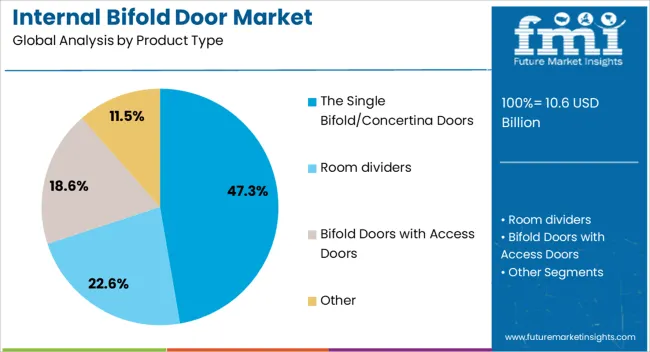
The single bifold or concertina doors segment is projected to hold 47.30% of the total market revenue by 2025 within the product type category, positioning it as the most dominant segment. This segment’s growth is attributed to its ease of installation, compact folding mechanism, and suitability for residential layouts where space utilization is critical.
The design enables smooth and efficient room partitioning without compromising on accessibility or natural light. Its compatibility with various design aesthetics and interior styles has further elevated consumer adoption.
As the demand for flexible and space-efficient solutions increases, the single bifold or concertina door format continues to outperform traditional door types in small to medium residential settings.
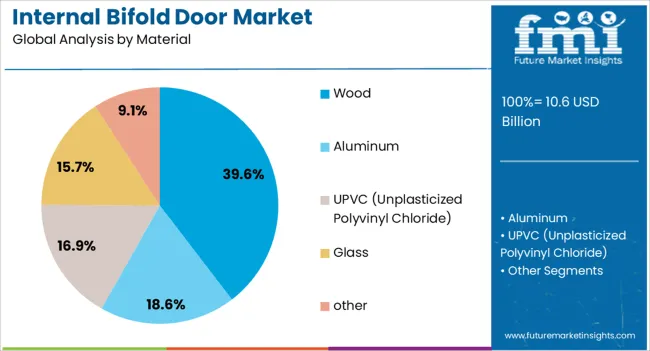
The wood segment is expected to contribute 39.60% of overall market revenue by 2025 within the material category, reflecting strong demand for natural textures and traditional appeal. Wood bifold doors are favored for their versatility in finishes, durability, and ability to complement a wide range of interior décor themes.
Moreover, growing consumer inclination toward eco conscious materials and biophilic design is driving preference for responsibly sourced wooden doors. Manufacturers are leveraging engineered wood and sustainable forestry certifications to meet rising expectations for both performance and environmental responsibility.
The enduring aesthetic and tactile quality of wood remains a key driver of its continued dominance in material selection for bifold doors.
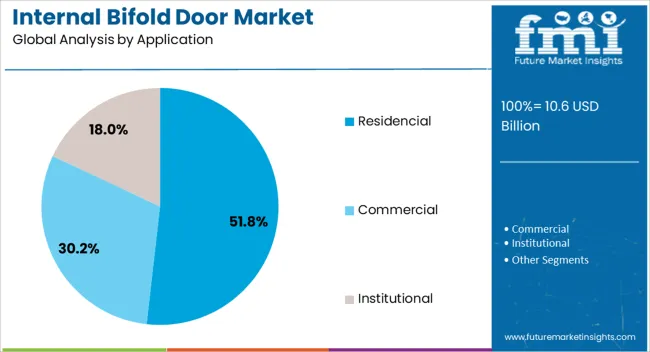
The residential segment is anticipated to hold 51.80% of total market revenue by 2025 under the application category, establishing it as the leading end use sector. This growth is being fueled by increasing adoption of bifold doors in living rooms, kitchens, wardrobes, and home offices where space efficiency and flexibility are paramount.
As open concept living and multi-use spaces gain popularity, bifold doors provide a practical solution to maintain fluidity while offering privacy when needed. Additionally, rising investments in home remodeling, urban apartment developments, and smart interior layouts are amplifying demand in this segment.
The aesthetic adaptability and functional benefits of bifold doors continue to reinforce their stronghold in the residential market.
Emerging trends in customizable and high-performance materials are reshaping the market. However, challenges such as high initial costs and installation complexity remain barriers to wider adoption. By 2025, addressing these challenges through cost-effective solutions and simplified installation will be key to sustaining market growth and expanding the reach of bifold doors across various consumer segments.
The internal bifold door market is experiencing significant growth due to the increasing demand for space-saving and functional interior solutions. Bifold doors are particularly popular in modern homes, offices, and commercial spaces because they provide an efficient way to divide rooms while optimizing available space. As homeowners and businesses focus on enhancing the aesthetic appeal and functionality of their interiors, the demand for bifold doors is expected to continue growing. By 2025, the market will expand as more people seek customizable, flexible door solutions to meet their needs.
Opportunities in the internal bifold door market are growing as the residential and commercial construction sectors expand. Bifold doors offer an ideal solution for modern architectural designs, where open-plan layouts and the use of natural light are prioritized. The growing focus on interior aesthetics and functional design in both residential and commercial properties is fueling the adoption of bifold doors. By 2025, increasing investments in new housing projects and commercial buildings will continue to drive the market as consumers look for versatile and stylish interior solutions.
Emerging trends in the internal bifold door market include the growing demand for customizable and high-performance materials. Consumers are increasingly seeking doors that offer both aesthetic appeal and durability. This has led to the rise of bifold doors made from materials such as aluminum, wood, and glass, which provide enhanced performance and style. Additionally, custom-made bifold doors allow for greater flexibility in terms of size, color, and design, catering to the specific needs of consumers. By 2025, the market will continue to shift towards these highly customizable and durable solutions.
Despite growth, challenges such as high initial costs and installation complexity persist in the internal bifold door market. The cost of high-quality materials, such as aluminum or wood, can make bifold doors more expensive compared to traditional hinged doors. Additionally, the installation process can be intricate and requires skilled professionals, leading to higher installation costs. By 2025, overcoming these challenges will require more affordable pricing strategies and simplified installation methods to increase market accessibility for a broader range of consumers.
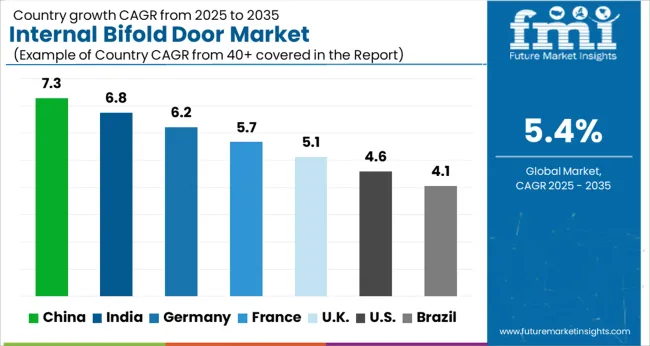
The global internal bifold door market is projected to grow at a 5.4% CAGR from 2025 to 2035. China leads with a growth rate of 7.3%, followed by India at 6.8%, and France at 5.7%. The United Kingdom records a growth rate of 5.1%, while the United States shows the slowest growth at 4.6%. These varying growth rates are driven by factors such as increasing demand for space-efficient, aesthetically pleasing, and versatile home and office interior solutions. Emerging markets like China and India are experiencing higher growth due to rapid urbanization, growing real estate development, and increased focus on modern interior design trends, while more mature markets like the USA and the UK see steady growth driven by the demand for energy-efficient solutions and the rise in home renovations. This report includes insights on 40+ countries; the top markets are shown here for reference.
The internal bifold door market in China is growing rapidly, with a projected CAGR of 7.3%. China’s expanding real estate sector, coupled with the increasing demand for space-efficient and modern interior solutions, is driving significant growth in the bifold door market. The country’s focus on improving urban living standards, along with a growing middle class, is further accelerating the demand for home and office renovation products like bifold doors. Additionally, the rise in interior design trends that emphasize aesthetic appeal, combined with the growing popularity of open-plan spaces, supports the rapid adoption of internal bifold doors.
The internal bifold door market in India is projected to grow at a CAGR of 6.8%. India’s increasing focus on modern home and office interiors, coupled with the growing real estate sector, is fueling the demand for internal bifold doors. The rise in disposable incomes, urbanization, and a shift towards contemporary interior design are key factors driving market growth. Additionally, India’s increasing preference for space-efficient solutions in both residential and commercial buildings further boosts the demand for bifold doors. The growing trend of home and office renovations also contributes to market expansion.
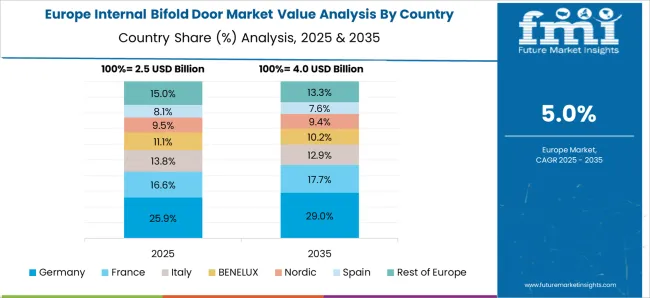
The internal bifold door market in France is projected to grow at a CAGR of 5.7%. France’s growing demand for stylish, functional, and space-saving solutions in home and office interiors is driving steady growth in the bifold door market. The country’s strong real estate development and renovation sector, combined with increasing consumer interest in energy-efficient and aesthetically appealing home solutions, contribute to the market expansion. Additionally, France’s focus on sustainability and green building practices, including the adoption of energy-efficient doors, further accelerates the adoption of internal bifold doors in residential and commercial projects.
The internal bifold door market in the United Kingdom is projected to grow at a CAGR of 5.1%. The UK’s growing interest in home renovations and office space optimization is driving steady demand for internal bifold doors. The rise in demand for space-efficient, aesthetically pleasing, and functional solutions in modern homes and offices is further contributing to market growth. Additionally, the increasing popularity of sustainable and energy-efficient building solutions, along with government initiatives supporting eco-friendly building practices, continues to drive the adoption of internal bifold doors in the UK
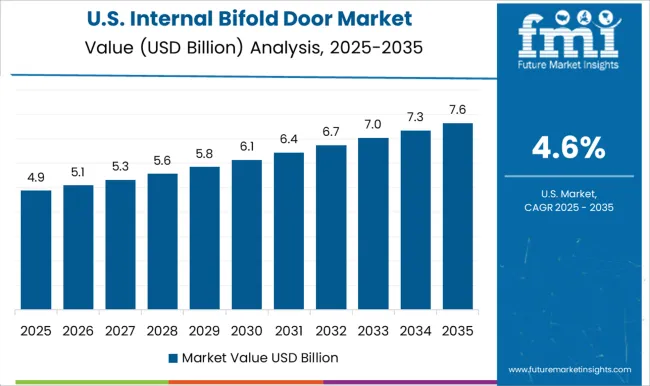
The internal bifold door market in the United States is expected to grow at a CAGR of 4.6%. The USA market is driven by the increasing demand for space-saving and versatile interior solutions in residential and commercial buildings. The growing trend of open-plan living, along with a rising focus on energy-efficient, sustainable building solutions, is supporting market growth. Additionally, the USA real estate sector’s ongoing recovery, coupled with the increasing popularity of home improvement and renovation projects, further boosts the demand for internal bifold doors in both new constructions and renovation projects.
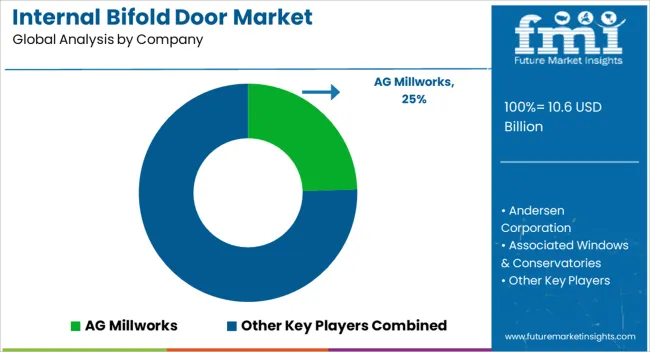
The internal bifold door market is led by AG Millworks, which has established a strong position with its premium bifold doors that emphasize aesthetics, energy efficiency, and functionality. The company’s dominance is reinforced by its focus on craftsmanship, bespoke customization, and reliable service, making it a preferred choice for both residential and commercial projects. Andersen Corporation, Jeld-Wen, and Pella Corporation hold significant shares, supported by their wide product portfolios that cater to diverse architectural styles while meeting energy performance standards. Their strategies focus on enhancing product durability, expanding design options, and introducing features like noise insulation, security enhancements, and weatherproofing to meet evolving customer needs.
Emerging competitors such as Marvin, Hormann, and Milgard Windows & Doors are expanding their footprint by offering bifold door solutions tailored to niche segments, including modern architecture, green building projects, and commercial spaces. Their differentiation is driven by premium materials, high customization levels, and energy-efficient configurations designed to appeal to both homeowners and property developers. Competition is increasingly shaped by innovation in materials, smart integration, and automated systems.
Growth in this industry is being accelerated by rising adoption of space-saving designs in residential settings and the demand for energy-efficient solutions in commercial buildings. Advances in automated mechanisms, integration of smart technologies, and development of lightweight yet durable materials are expected to define the next phase of competitive positioning. These dynamics are reinforcing the role of internal bifold doors as a preferred choice in modern construction and renovation projects.
| Item | Value |
|---|---|
| Quantitative Units | USD 10.6 Billion |
| Product Type | The Single Bifold/Concertina Doors, Room dividers, Bifold Doors with Access Doors, and Other |
| Material | Wood, Aluminum, UPVC (Unplasticized Polyvinyl Chloride), Glass, and other |
| Application | Residencial, Commercial, and Institutional |
| Price Range | Low (Below $100), Medium ($100-$200), and High (Above $200) |
| Distribution Channels | Online and Offline |
| Regions Covered | North America, Europe, Asia-Pacific, Latin America, Middle East & Africa |
| Country Covered | United States, Canada, Germany, France, United Kingdom, China, Japan, India, Brazil, South Africa |
| Key Companies Profiled | AG Millworks, Andersen Corporation, Associated Windows & Conservatories, ATIS Group, AWM Building Maintenance Ltd., Hormann, Jeld-Wen, JELD-WEN Inc., Kawneer, Marvin, Milgard Windows & Doors, Pella Corporation, Ply Gem Industries Inc., Schuco, Simpson Doors, VELUX, and Western Window Systems |
| Additional Attributes | Dollar sales by door type and application, demand dynamics across residential, commercial, and retail sectors, regional trends in internal bifold door adoption, innovation in space-saving and eco-friendly materials, impact of regulatory standards on safety and performance, and emerging use cases in home automation and modern interior design. |
The global internal bifold door market is estimated to be valued at USD 10.6 billion in 2025.
The market size for the internal bifold door market is projected to reach USD 18.0 billion by 2035.
The internal bifold door market is expected to grow at a 5.4% CAGR between 2025 and 2035.
The key product types in internal bifold door market are the single bifold/concertina doors, room dividers, bifold doors with access doors and other.
In terms of material, wood segment to command 39.6% share in the internal bifold door market in 2025.






Full Research Suite comprises of:
Market outlook & trends analysis
Interviews & case studies
Strategic recommendations
Vendor profiles & capabilities analysis
5-year forecasts
8 regions and 60+ country-level data splits
Market segment data splits
12 months of continuous data updates
DELIVERED AS:
PDF EXCEL ONLINE
Internal Olefins Market Size and Share Forecast Outlook 2025 to 2035
Internal Gear Pump Market Size, Growth, and Forecast 2025 to 2035
Internal Radiation Therapy Market Trends – Growth & Forecast 2024-2034
Doors Market Size and Share Forecast Outlook 2025 to 2035
Door Hardware Market
Door Controller Systems Market
Indoor Rotary High Voltage Disconnect Switch Market Size and Share Forecast Outlook 2025 to 2035
Indoor Cable Assemblies Market Size and Share Forecast Outlook 2025 to 2035
Indoor Residential Switchgear Market Size and Share Forecast Outlook 2025 to 2035
Indoor Air Quality Monitor Market Size and Share Forecast Outlook 2025 to 2035
Indoor Location Market Size and Share Forecast Outlook 2025 to 2035
Indoor Space Heater Market Size and Share Forecast Outlook 2025 to 2035
Indoor Farming Market Analysis - Size, Share, and Forecast 2025 to 2035
Indoor Smokehouses & Pig Roasters Market – Smoked Meat Processing 2025 to 2035
A Detailed Global Analysis of Brand Share for the Indoor Farming Market
Outdoor Boundary Vacuum Load Switch Market Size and Share Forecast Outlook 2025 to 2035
Outdoor LED Lighting Market Size and Share Forecast Outlook 2025 to 2035
Outdoor Payment Terminal Market Size and Share Forecast Outlook 2025 to 2035
Outdoor Commercial Grills Market Size and Share Forecast Outlook 2025 to 2035
Outdoor Kitchen Appliances Market Size and Share Forecast Outlook 2025 to 2035

Thank you!
You will receive an email from our Business Development Manager. Please be sure to check your SPAM/JUNK folder too.
Chat With
MaRIA